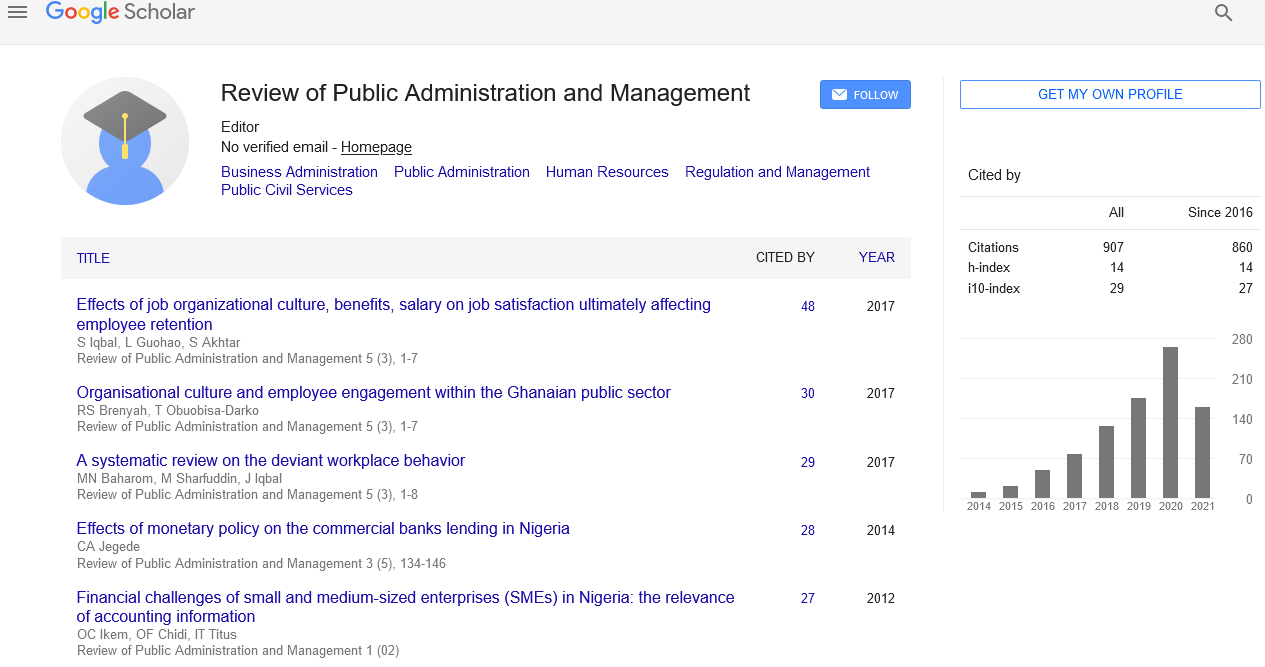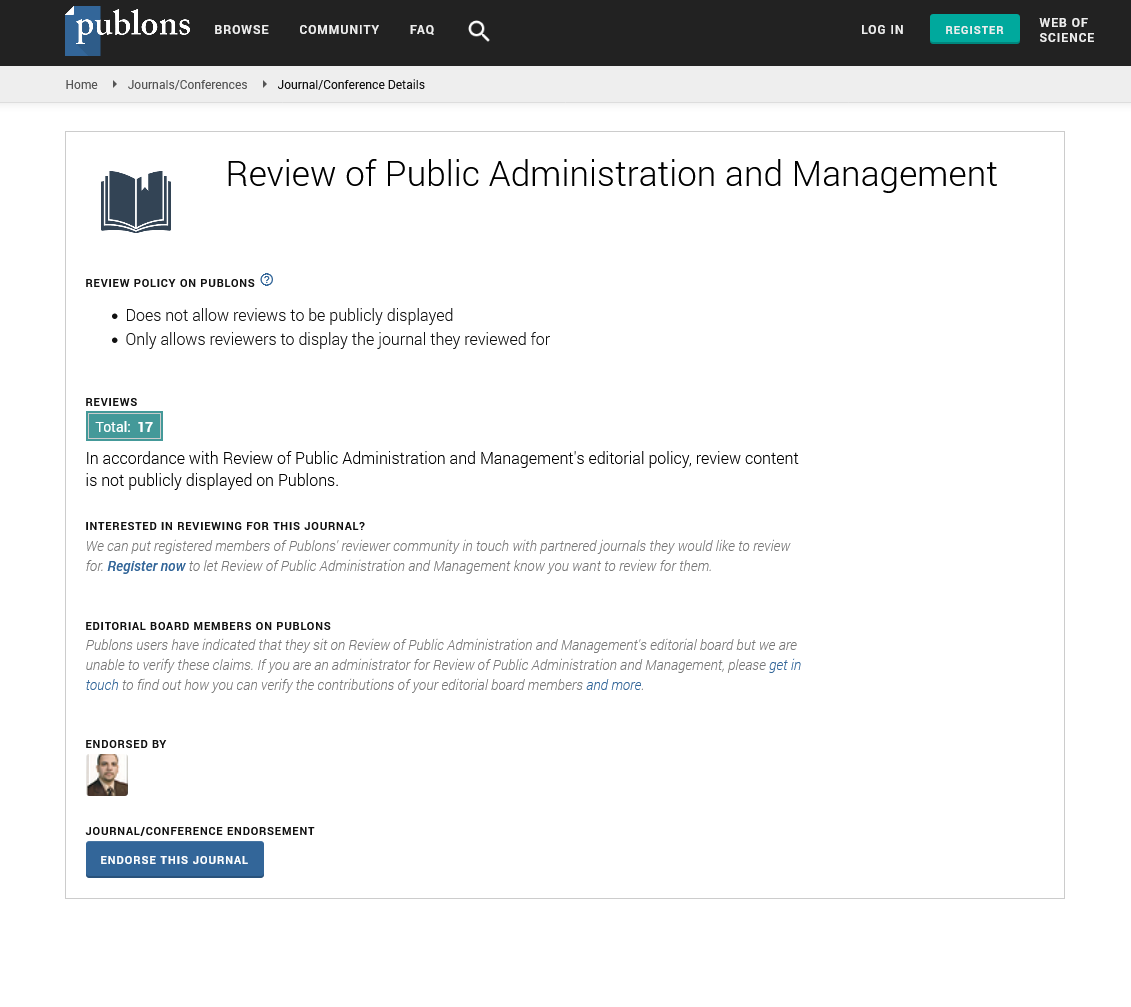Indexed In
- CiteFactor
- RefSeek
- Directory of Research Journal Indexing (DRJI)
- Hamdard University
- EBSCO A-Z
- Scholarsteer
- Publons
- Euro Pub
- Google Scholar
Useful Links
Share This Page
Journal Flyer

Open Access Journals
- Agri and Aquaculture
- Biochemistry
- Bioinformatics & Systems Biology
- Business & Management
- Chemistry
- Clinical Sciences
- Engineering
- Food & Nutrition
- General Science
- Genetics & Molecular Biology
- Immunology & Microbiology
- Medical Sciences
- Neuroscience & Psychology
- Nursing & Health Care
- Pharmaceutical Sciences
Opinion Article - (2025) Volume 13, Issue 1
Crisis Governance: Evaluating Public Sector Response to Global Pandemics
James Carter*Received: 24-Feb-2025, Manuscript No. RPAM-25-29219; Editor assigned: 26-Feb-2025, Pre QC No. RPAM-25-29219; Reviewed: 12-Mar-2025, QC No. RPAM-25-29219; Revised: 18-Mar-2025, Manuscript No. RPAM-25-29219; Published: 26-Mar-2025, DOI: 10.35248/2315-7844.25.13.477
Description
The COVID-19 pandemic marked a turning point in the field of public administration, bringing the role of government into sharp focus and exposing the strengths and weaknesses of crisis governance around the globe. Pandemics are not only health emergencies; they are complex crises that test the resilience of administrative systems, policy frameworks and leadership capacities. The effectiveness of the public sector's response during such global health crises depends largely on institutional preparedness, inter-agency coordination, transparency, trust in governance and adaptability in the face of evolving threats. Evaluating these factors provides critical insight into how governments can better manage future pandemics and protect public well-being. Public sector crisis governance refers to the strategies and mechanisms employed by government institutions to prepare for, respond to and recover from emergency situations. Unlike routine service delivery, crisis governance requires rapid decision-making, dynamic coordination and effective communication. The unpredictability and scale of global pandemics demand that governments respond with agility, flexibility and foresight. However, the suddenness of such events often reveals systemic vulnerabilities in public health infrastructure, emergency planning, logistics and social protection systems.
A key element in evaluating public sector response is institutional preparedness. This includes having national pandemic response plans, early warning systems, adequate stockpiles of medical supplies and a trained public health workforce. Countries that had robust preparedness frameworks in place such as South Korea and Taiwan were able to respond more quickly and effectively to COVID-19. Their early investments in digital surveillance, contact tracing and public health infrastructure allowed for timely interventions and containment measures. In contrast, countries lacking coherent emergency plans faced overwhelmed healthcare systems, delayed policy responses and higher mortality rates. Leadership and decision-making structures also play a critical role in pandemic response. Centralized leadership, clear chains of command and political unity have proven beneficial during crises. Governments that empowered health experts, coordinated between federal and local authorities and followed science-based strategies were generally more successful in managing the pandemic. In countries where leadership was fragmented or where public health decisions were politicized, the response was less effective. For example, inconsistent messaging and delayed lockdowns in several nations led to public confusion, reduced compliance and worsened outcomes.
Another essential aspect of crisis governance is inter-agency coordination. Public health emergencies impact various sectors—transport, education, economy, labor and law enforcement—necessitating collaboration across different government departments and levels of governance. Effective response hinges on seamless coordination between national, regional and local authorities, as well as partnerships with non-governmental actors. Intersectoral task forces, unified command centers and joint information platforms have emerged as good practices in improving coordination and speeding up response times. Transparency and communication are central to building public trust and ensuring compliance with health directives. Governments that communicated openly, consistently and empathetically during the pandemic were able to cultivate greater public cooperation. Daily briefings, real-time updates, multilingual messaging and data sharing helped foster transparency and accountability. Conversely, misinformation, censorship, or lack of communication led to distrust, rumors and resistance to public health measures. Trust in institutions, therefore, becomes a decisive factor in public behavior during health crises.
Digital governance and innovation have also emerged as critical tools in pandemic response. Technology-enabled solutions such as mobile apps for contact tracing, AI-powered diagnostics, telemedicine platforms and electronic health records allowed for real-time monitoring and decentralized healthcare delivery. Governments that invested in digital infrastructure prior to the pandemic were better positioned to scale these tools quickly. However, digital solutions also raised concerns about data privacy, surveillance and equitable access—highlighting the need for robust legal and ethical frameworks in times of crisis. Social protection and equity-based interventions were key to mitigating the socioeconomic impact of the pandemic. Effective public sector responses included direct cash transfers, food distribution, rent freezes, unemployment benefits and support for informal workers. Countries that rapidly rolled out these interventions were able to cushion vulnerable populations and prevent deeper inequality. The crisis revealed stark disparities in access to healthcare, digital resources and financial support, particularly among marginalized groups, rural communities and women. This underscores the importance of inclusive governance that addresses both the health and social dimensions of pandemics.
Despite notable efforts, many governments struggled with logistical challenges, vaccine distribution, procurement bottlenecks and inconsistent implementation of lockdowns. Public sector capacity was often stretched thin, exposing limitations in health system readiness, emergency procurement and crisis logistics. The lack of coordination between public and private healthcare providers further complicated responses in some regions. Additionally, global supply chain disruptions and dependence on foreign medical goods revealed the need for resilient, self-sufficient systems. One important lesson from the pandemic is the value of adaptive governance—the ability of public institutions to learn, evolve and adjust strategies in real time. Governments that continuously assessed their policies, incorporated feedback and adjusted their approach based on data fared better in managing ongoing waves of infection. Flexibility, rather than rigid planning, proved essential in responding to an unpredictable and fast-changing crisis landscape.
Citation: Carter J (2025). Crisis Governance: Evaluating Public Sector Response to Global Pandemics. Review Pub Administration Manag.13: 477.
Copyright: © 2025 Carter J. This is an open access article distributed under the terms of the Creative Commons Attribution License, which permits unrestricted use, distribution and reproduction in any medium, provided the original author and source are credited.


